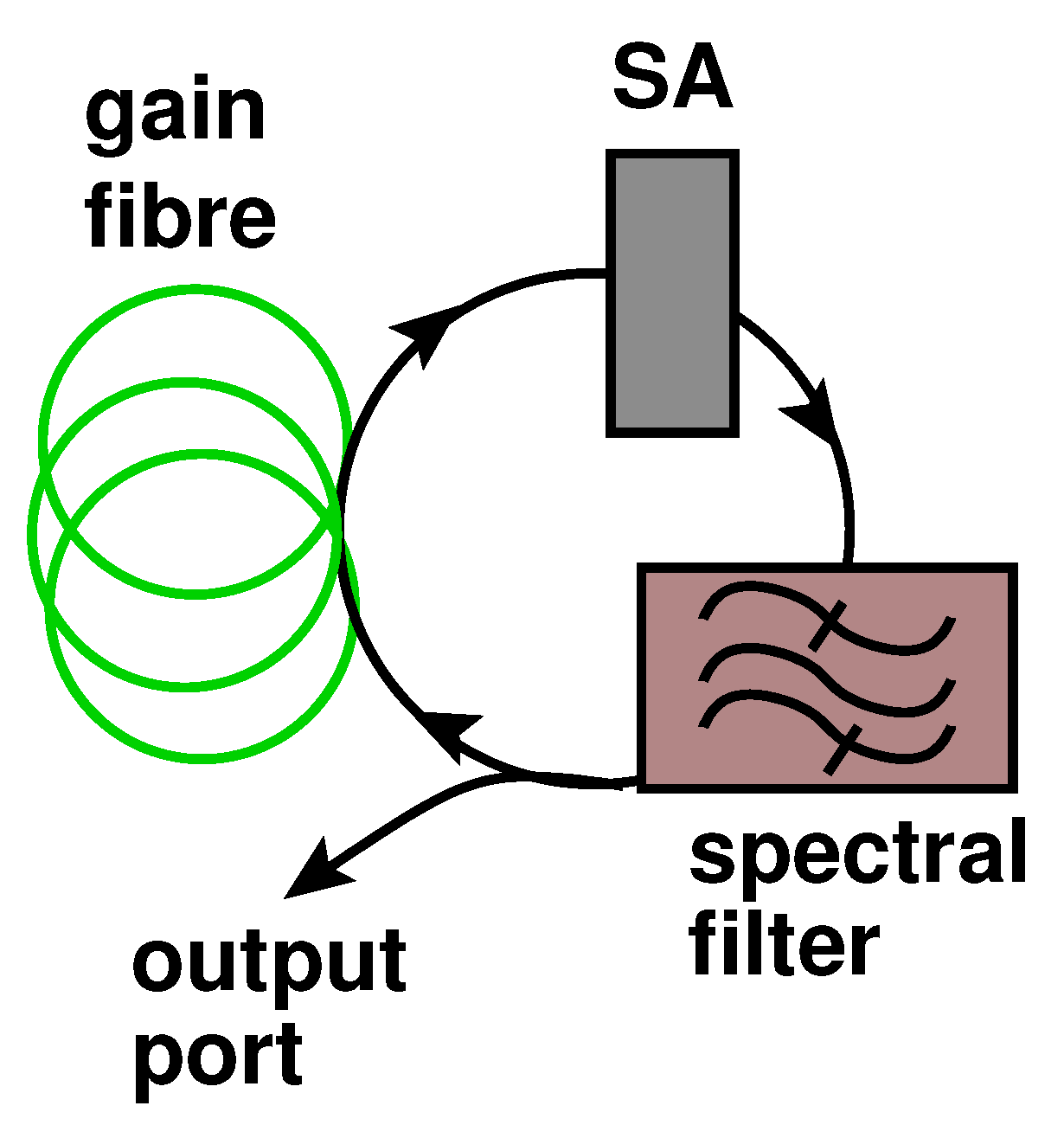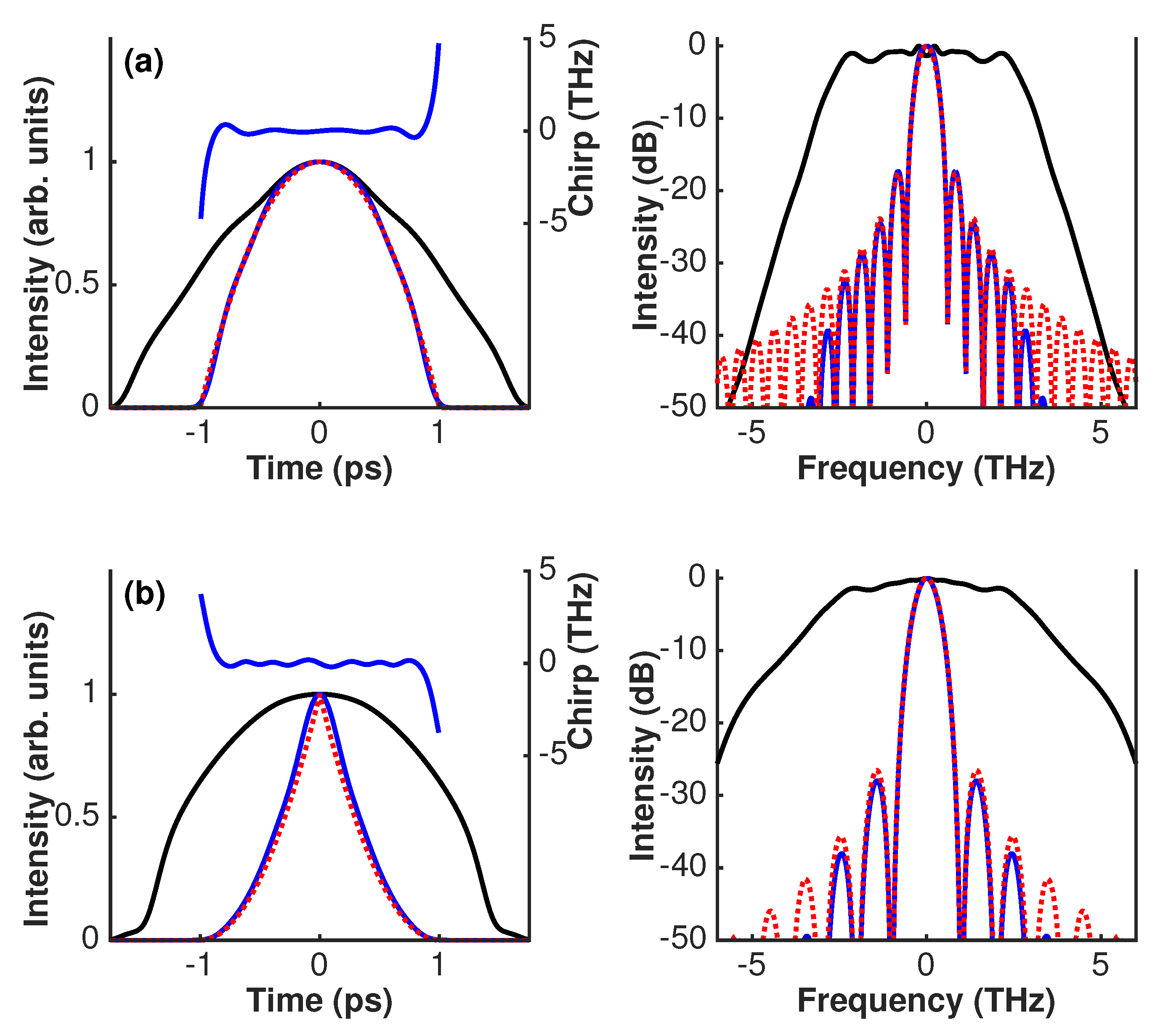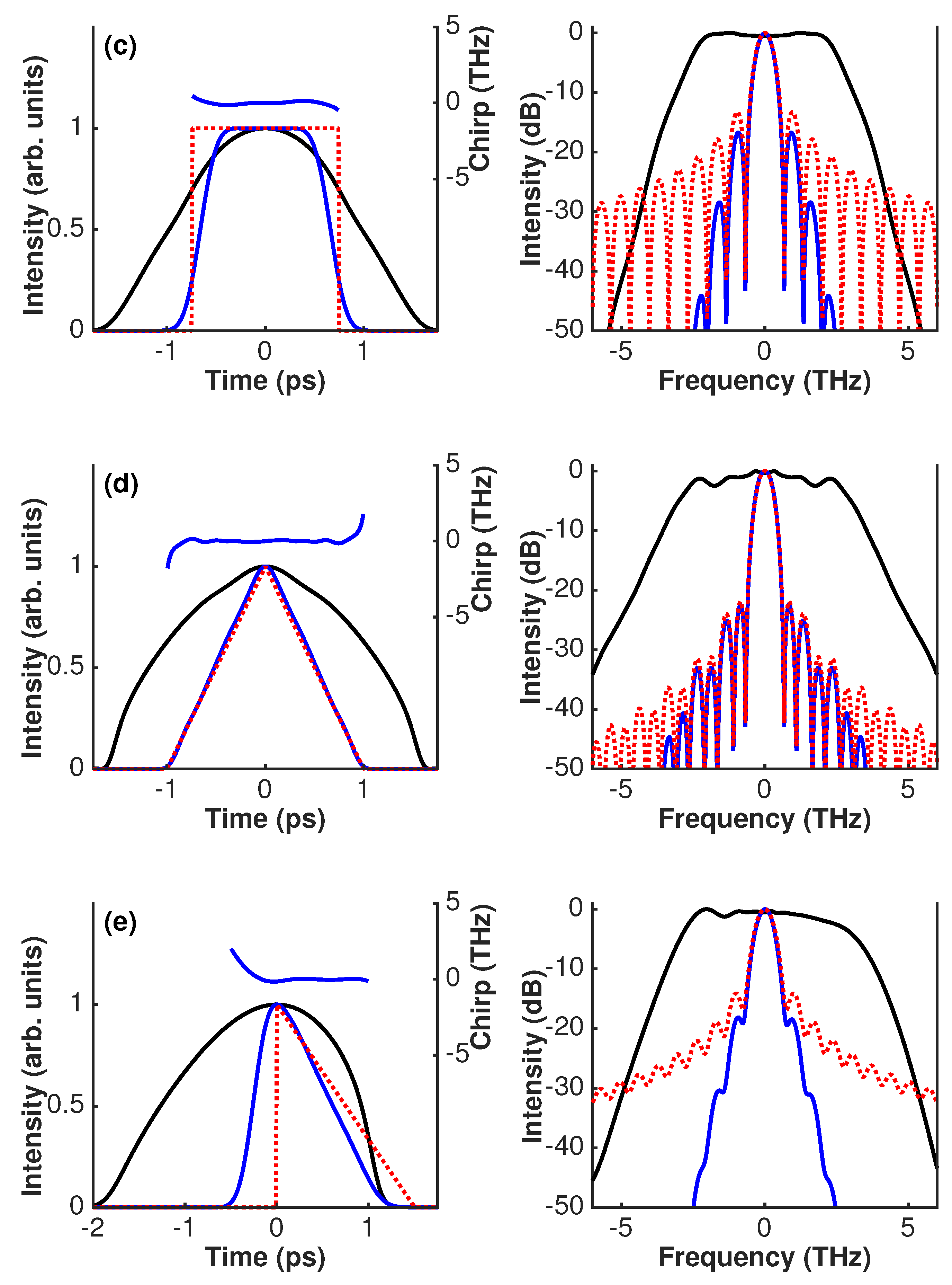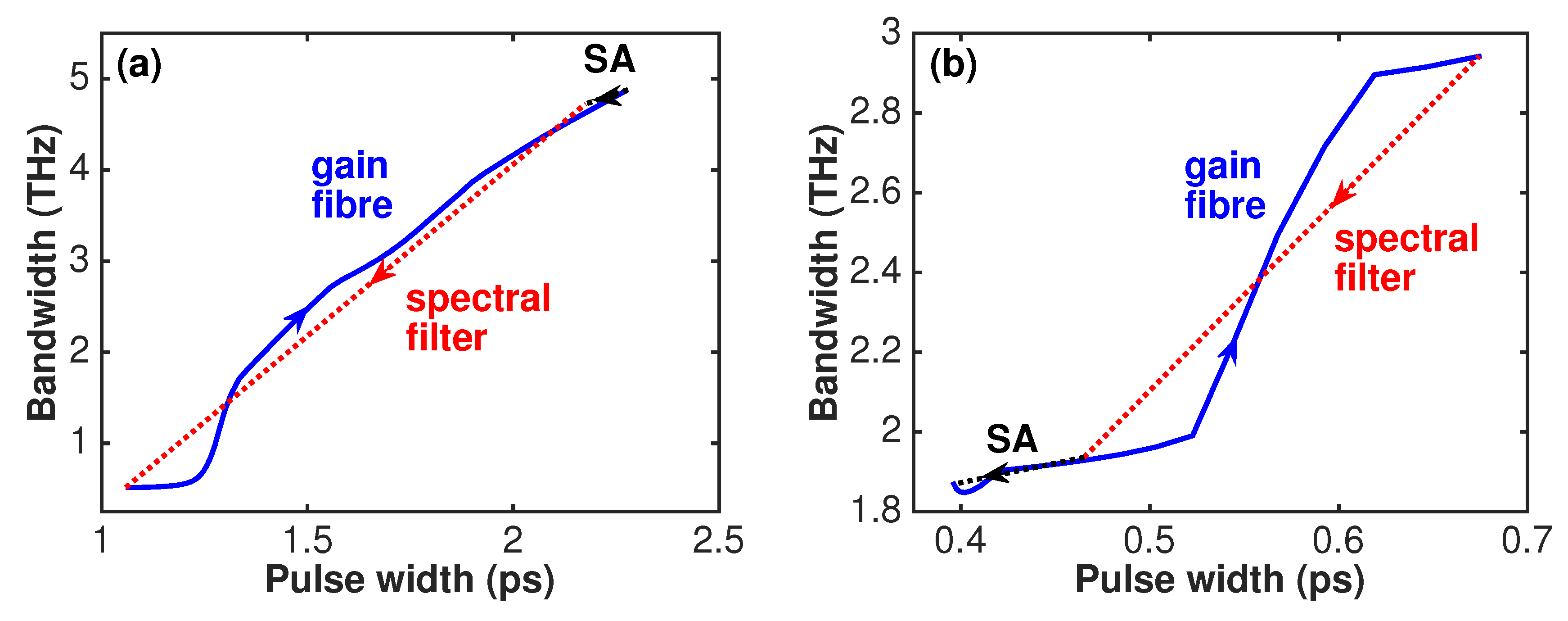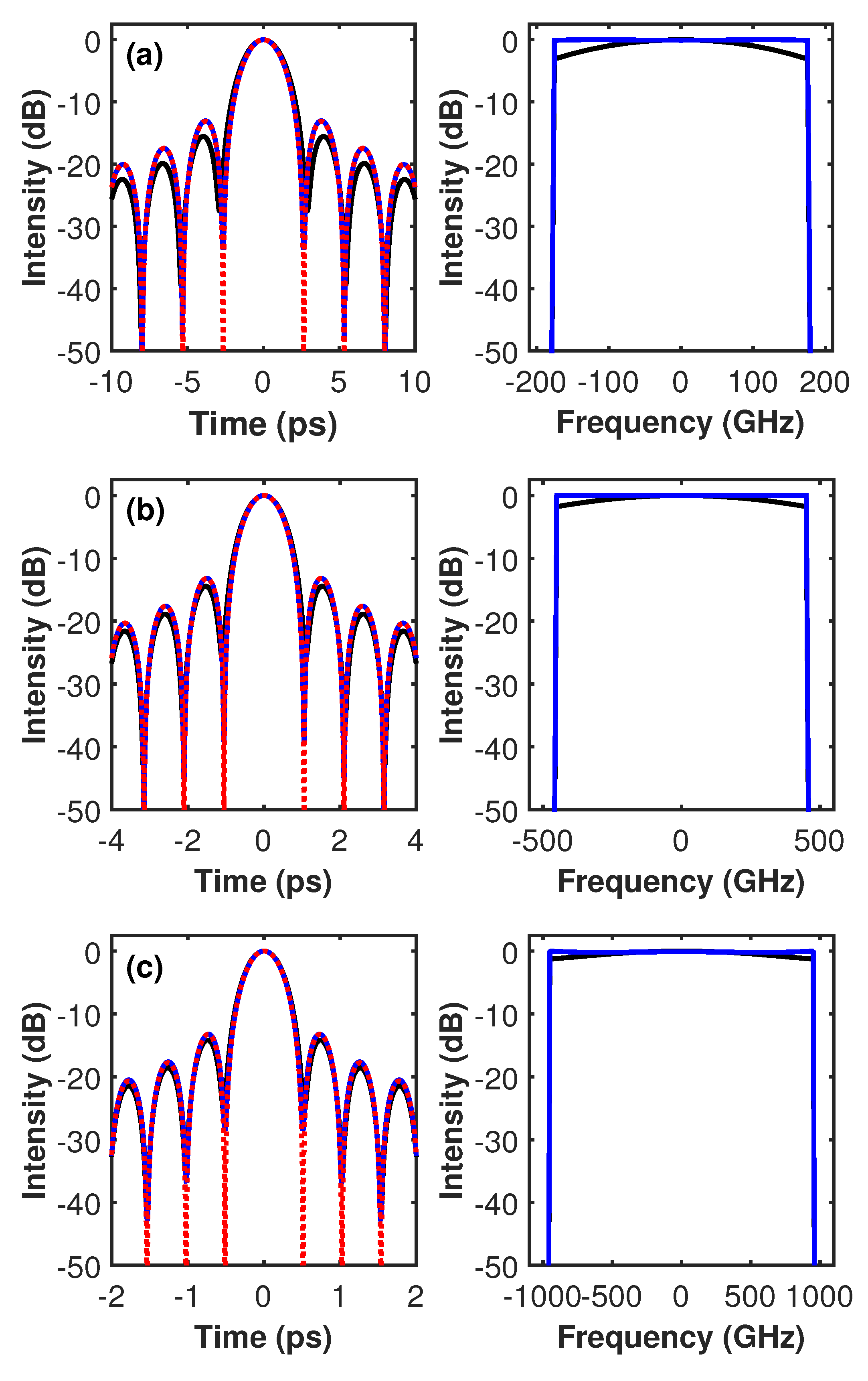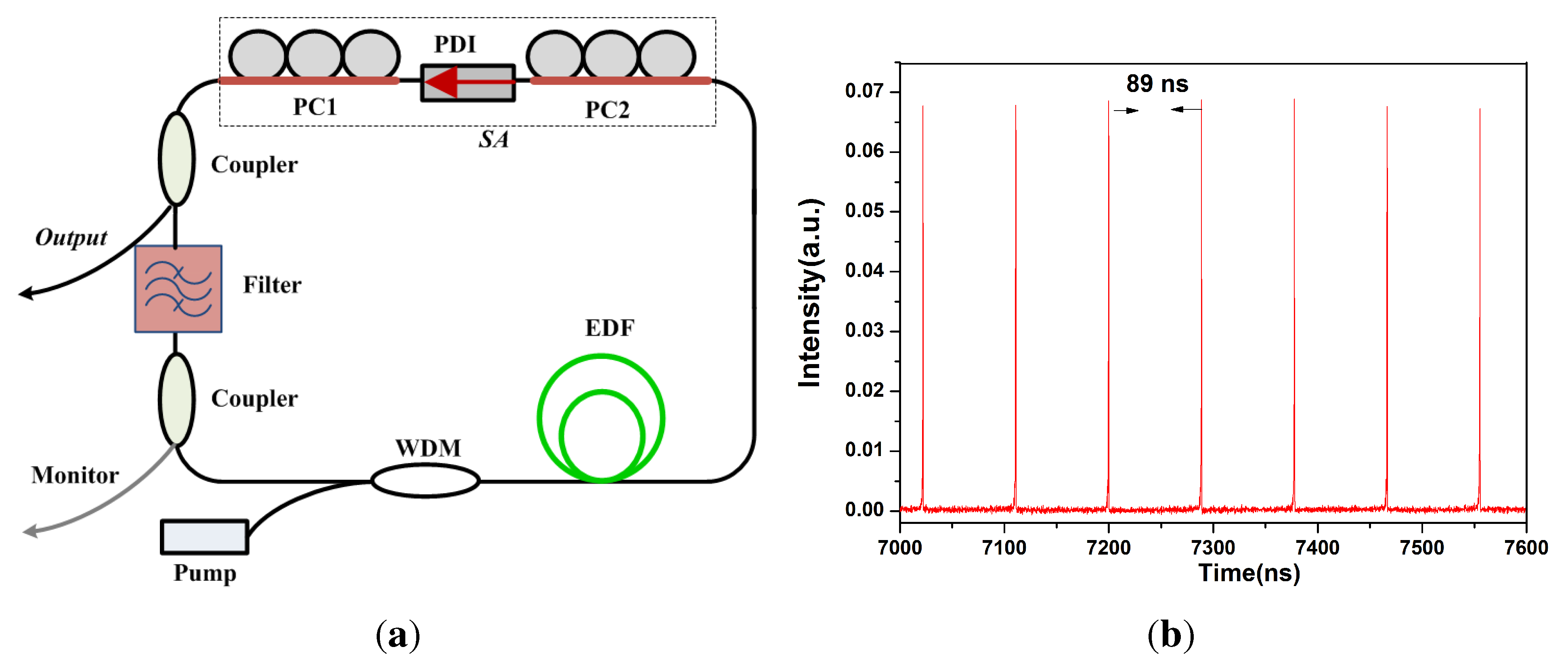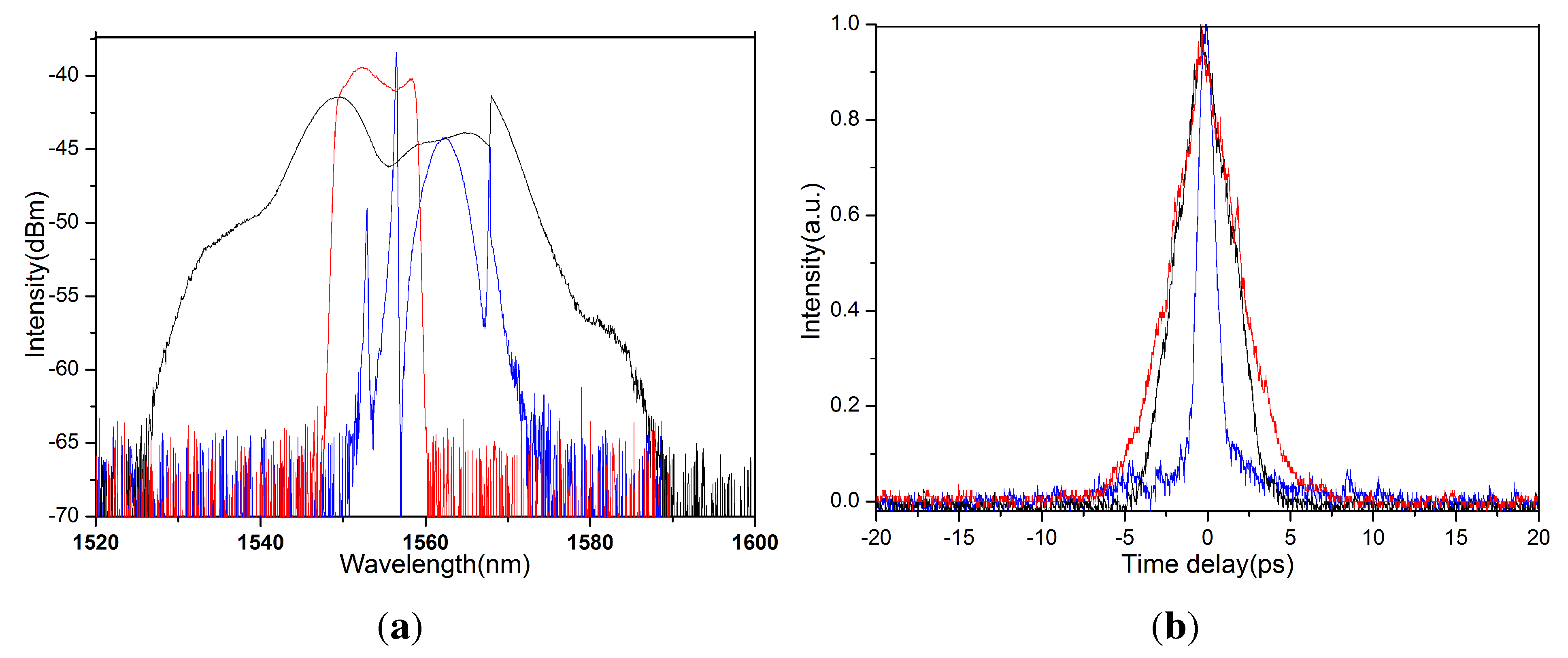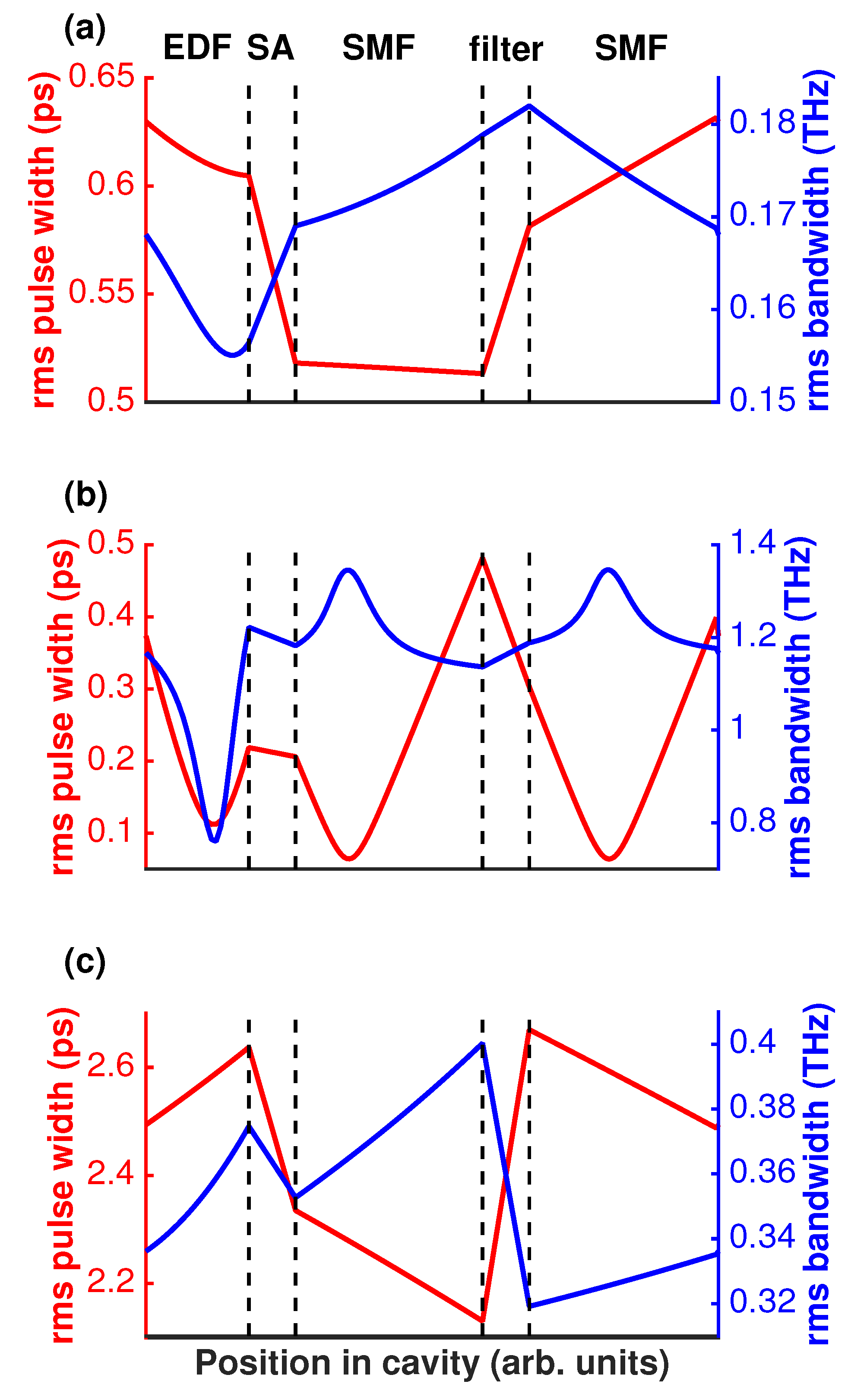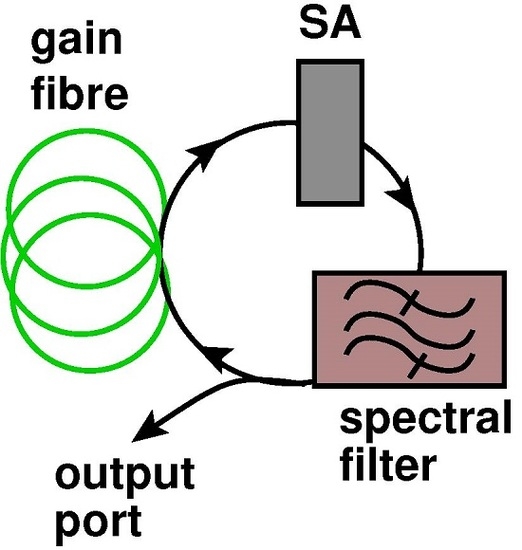2.1. Design Rationale and Numerical Model
The design of in-cavity pulse shaping by spectral filtering exploits the understanding gained by our recent work [
34]. The cavity configuration considered is a simple ring cavity, as shown in
Figure 1. A short (a few meters) segment of rare-earth doped fibre with normal GVD acts as the gain and nonlinear element of the cavity. The gain fibre is followed by a saturable absorber (SA) element initiating and stabilising the mode-locked operation and an amplitude and phase spectral filter, which realises the pulse shaping. Note that for the Nyquist pulse shaping described thereafter, the positioning of the SA and filter in the cavity is reversed, as we found that coupling the filter to receive output light from the fibre amplifier enabled a wider tunability range for the filter bandwidth. The output of the laser is monitored behind a coupler at the output of the filter. Pulse propagation in the laser cavity can be described by a theoretical model that includes the dominant physical effects of the system on the evolution of a pulse over one round trip inside the cavity [
38]. These effects include GVD, SPM, gain saturation and bandwidth-limited gain for the active fibre, as well as the discrete effects of the SA and spectral filter. The evolution in the fibre section is described by a standard modified nonlinear Schrödinger equation [
38]:
where
is the slowly-varying amplitude of the pulse envelope,
z and
t are the propagation and time delay parameters,
is the GVD parameter and
γ is the coefficient of the cubic nonlinearity of the fibre. The gain is saturated according to
, where
is the small-signal gain,
is the pulse energy and
is the gain saturation energy determined by the pump power. The action of the fast SA is approximated by a simplified, but generic, nonlinear transfer function describing its transmittance [
38]:
, where
is the unsaturated loss due to the absorber,
is the instantaneous pulse power and
is the saturation power. The filter is modelled by the spectral response
, where
is the Fourier transform of a certain objective waveform function
, and the spectral phase adds a specific amount of GVD to the cavity. By varying the curvature
(in
) of the parabolic phase function, we can control the net dispersion of the cavity. The numerical model is solved with a standard symmetric split-step propagation algorithm, and the initial field is a picosecond Gaussian temporal profile. The following parameters, typical of ytterbium-doped fibres [
7], are used in the simulations:
,
, and Ω corresponds to a 40-nm bandwidth at FWHM. Furthermore,
corresponds to 30 dB/m in power,
pJ,
W, and 70% of laser power is tapped out of the cavity.
The main pulse-shaping mechanism of our laser design relies on enhanced spectral filtering of a nonlinearly spectrally-broadened pulse in the cavity [
34]. A significant nonlinear phase shift is impressed on the pulse in the fibre section. The spectral filter compensates both the broad pulse duration and bandwidth after the fibre segment. The principle of filtering a strongly-phase-modulated pulse both in frequency and time has already been exploited to achieve new mode-locking regimes in fibre lasers [
8,
10]. In [
34], we extended this approach to more complex features. Because the nonlinearly-broadened spectrum of the pulse at the output of the fibre is wider than the filter’s spectral response and fairly flat within the filter bandwidth (see
Figure 2), it can be sliced without caring for the details of its structure [
39]. This is the enabling mechanism for the formation of pulses of the desired temporal shape at the output of the filter, impressed on the pulse by the filter’s impulse response. Note that unlike the cavity design presented in [
34], here, we do not employ an additional passive nonlinear propagation stage in the cavity. This notwithstanding, the spectral broadening in the gain fibre segment is still sufficient to operate a convenient reshaping. It is also worth noting that steady-state pulse shaping in an oscillator requires the generated pulse to fulfil the constraints imposed by the cavity, and the formation of a self-consistent solution in the cavity is in general a non-trivial problem. Despite substantial research in this field, qualitatively new phenomena are still being unveiled.
Figure 1.
Schematic of the laser. SA: saturable absorber.
Figure 1.
Schematic of the laser. SA: saturable absorber.
Figure 2.
Temporal intensity and chirp profiles (left) and spectral intensity profiles (right) of the output pulse from the laser (blue) for a (a) bright parabolic, (b) dark parabolic, (c) flat-top, (d) triangular and (e) saw-tooth impulse response of the spectral pulse shaper. Also shown are the target profiles (red dotted) and the profiles at the exit of the gain fibre (black).
Figure 2.
Temporal intensity and chirp profiles (left) and spectral intensity profiles (right) of the output pulse from the laser (blue) for a (a) bright parabolic, (b) dark parabolic, (c) flat-top, (d) triangular and (e) saw-tooth impulse response of the spectral pulse shaper. Also shown are the target profiles (red dotted) and the profiles at the exit of the gain fibre (black).
2.2. Tailored Pulse Waveform Generation
As an illustration of the general pulse-shaping principle described above, we consider here the generation of five different amplitude functions [
34], which represent some examples of interesting optical waveforms for applications in optical signal processing and manipulation [
35]. We use a bright parabolic pulse-shaping filter with
,
ps; a dark parabolic pulse shaper, such that
with
ps; a flat-top pulse shaper where
with
ps; a triangular pulse shaper where
with
ps; and a saw-tooth pulse shaper, where we define
in
,
, otherwise, with
ps. Here,
is the Heaviside function. The spectral filter can be realised in a variety of ways, such as a fibre Bragg grating or even a programmable liquid-crystal-on-silicon (LCoS) optical processor, which offers the additional advantage of being easily reconfigurable [
29].
The pulse solutions obtained for the different amplitude profiles applied on the filter and net GVD of 0.008
are shown in
Figure 2. It is seen that the desired pulse shapes are obtained at the output of the laser. In the case of flat-top and saw-tooth waveform functions, because of the sharp edges of these pulse shapes, an additional Gaussian bandpass filter with a bandwidth at FWHM of 1.7 THz is included in the pulse shaper to make the top of the resulting pulse ripple-free and to smooth the formed pulse shape, respectively. The generated pulses are nearly transform-limited. However, as opposed to the chirp (instantaneous frequency shift) profile targeted by the filter, the chirp profile of the generated pulses may exhibit a small ripple. This indicates that generating pulses with a well-defined phase profile by use of the method described here is not as straightforward. The pulse evolution, illustrated in
Figure 3a by plots of the FWHM pulse duration and spectral bandwidth as functions of position in the cavity, highlights the basis of the pulse-shaping mechanism being used. The evolution shown for the triangular pulse-shaping regime is representative of those observed for the other shaping regimes, too, in which the typical pulse parameters evolve in a closely-similar fashion along the cavity, though small quantitative differences may exist. It is seen that the nonlinear evolution in the gain fibre is monotonic with the growth of temporal and spectral widths, while the pulse acquires a positive (normal) chirp. The filter compensates for temporal and spectral broadening and cancels the temporal phase accumulation in the fibre. Although the SA is not significant in shaping the pulse, it improves the stability of the laser by attenuating low-amplitude wings that can grow over many cavity round trips. The peak nonlinear phase shift
(
is the pulse peak power), which the pulse accumulates in the gain fibre (also known as the
B-integral), is approximately 12 rad in the example of
Figure 3a. This is accommodated by a spectral breathing factor (defined as the ratio of the spectral width at FWHM at the input and the output of the filter) of approximately nine. This confirms that the intended pulse shaping in our laser design is achieved through enhanced spectral filtering of a nonlinearly-broadened pulse in the cavity [
34].
To gain a broader understanding of the laser dynamics, we investigated the effect of net dispersion on the laser response. The results [
34] revealed that the potential of tuning the output pulse temporal duration through in-cavity linear chirping is minimal. This stems from the filtering process being used,
i.e., slicing of a fairly broader spectrum, and indicates that one should act directly on the impulse response function of the filter to control the output pulse width. This result is not surprising, in fact, as a triangular, parabolic or flat-top temporal profile is rather sensitive to group delay. Note that, as we shall see in
Section 3, the net dispersion is controlled by adjusting the transfer function of the pulse shaper [
29]; therefore, no physical change in the cavity is required in order to change the output from one pulse shape to another, provided that a programmable pulse shaper is used.
Figure 3.
Phase diagrams representing the combined evolution of the FWHM temporal and spectral widths of the pulse over one round-trip in the cavity for: (a) a spectral pulse shaper with a triangular impulse response and a net cavity dispersion of ; (b) a flat-top spectral pulse shaper with THz (ps) and in the absence of in-cavity dispersion control.
Figure 3.
Phase diagrams representing the combined evolution of the FWHM temporal and spectral widths of the pulse over one round-trip in the cavity for: (a) a spectral pulse shaper with a triangular impulse response and a net cavity dispersion of ; (b) a flat-top spectral pulse shaper with THz (ps) and in the absence of in-cavity dispersion control.
2.3. Bandwidth Programmable Optical Nyquist Pulse Generation
In this section, we describe the application of our method for in-cavity pulse shaping to the generation of optical Nyquist pulses [
36]. The rectangular spectrum of sinc-shaped Nyquist pulses enables bandwidth-efficient encoding of data, which is of key interest for high-capacity optical communication systems (see, e.g., [
40] and the references therein). Besides optical communications, sinc pulses can bring benefits to many other fields, such as all-optical sampling [
41], microwave photonics [
42] and light storage [
43]. Various techniques to optically generate Nyquist pulses have been demonstrated, including spectral reshaping of a mode-locked laser [
44] or fibre optical parametric amplification [
45]. Additionally, sequences of very high-quality sinc-shaped pulses were obtained by the direct synthesis of a phase-locked frequency comb [
46]. Furthermore, a Nyquist laser that can directly emit an optical Nyquist pulse train was recently demonstrated [
47]. In the laser design reported in [
47], the generation of Nyquist pulses is made possible by a combination of parabolic time-domain shaping at the pulse peak with an optical intensity modulator and spectral-domain shaping on the pulse wings with a spectral filter. In our passively-mode-locked laser design, the incorporation of a simple flat-top spectral filter in the cavity makes it possible to generate sinc-shaped Nyquist pulses of high quality. Furthermore, the use of a filter’s profile with a corrective convex top can compensate for the concavity of the pulse spectrum obtained after nonlinear expansion in the fibre, thereby relaxing the need for large nonlinear phase accumulation in the fibre. The simplicity of our fibre laser design is appealing for implementation in experiments. It is typical in optical communications that the availability of a certain technical solution refocuses research on the feasibility of simpler or more cost-efficient versions.
For the demonstration of Nyquist pulse generation, the amplitude profile
of the filter’s spectral response is chosen to have sharply-decaying edges outside its bandwidth and a Gaussian top,
where
is the spectral bandwidth (defined as the width of both edges of the spectrum tail),
is the time interval between zero crossings of the corresponding sinc-function-like impulse response and
α is an adjustable parameter defining the width and concavity of the spectrum top. Note that approximating the Gaussian function by the first two terms of its Taylor series,
i.e., by a quadratic function, in the filter’s response would yield similar results to those presented hereafter. For the special value
,
is the rectangular spectral profile associated with the Nyquist sinc-function impulse response [
44]:
while
(
) yields a convex or inverted (concave or conventional) Gaussian top. A variety of filters with very steep edges and adjustable bandwidth are readily available. The corrective Gaussian-top profile can be provided by a programmable LCoS optical processor, the shape and bandwidth of which can be software configured [
29]. Note that optimisation of the filter’s profile is relatively easy as it requires adjustment of only one parameter (
α). Note also that the sinc function in Equation (
3) defines a time unlimited pulse and, as a consequence of causality, is therefore only a theoretical construct. Instead, a pulse train as generated in the laser would be used in an experimental demonstration of Nyquist pulse shaping. However, given that the pulse repetition period would be significantly larger than the characteristic pulse width
, only a negligibly small side-band field would be created by the sinc function between adjacent pulses.
The solutions obtained for a flat-top spectral profile (
) applied on the filter with different related zero-crossing pulse durations are shown in
Figure 4, and compared to the solutions obtained with a convex Gaussian-top profile. The shape correction factor
α was optimised for each pulse duration, and no in-cavity dispersion control was used in these simulations. It is seen that the use of the basic rectangular shape for the filter’s spectral response already allows us to obtain sinc-shaped pulses at the output of the laser that coincide well with the theoretical ones described by Equation (
3) and feature a spectrum that is fairly close to the ideal rectangular case. When a convex spectral profile is applied to the filter, the correction of the non-perfectly-flattened pulse spectrum after the gain fibre by the filter brings about sinc pulses of enhanced quality and with an almost ideal rectangular spectrum at the laser output for all of the pulse durations being considered. The example of pulse evolution shown in
Figure 3b when the basic rectangular filtering method is employed demonstrates that the pulses are shaped by the same mechanism as that governing the pulse generation regimes described in the previous section (
Figure 3a). The initial slight decrease of the spectral bandwidth of the pulse in the gain fibre originates from the reshaping of the spectrum from a rectangular-like profile at the entrance of the fibre to a parabolic-like shape near the peak with a transition to a steep decay in the first stage of evolution in the fibre. After this stage, the spectrum broadens significantly and eventually develops the steep and structured edges characteristic of SPM. We also note that while the FWHM pulse duration decreases owing to spectral filtering, the root-mean-square (rms) duration is increased by the filter owing to the specific ringing feature (or ripples) on the pulse wings accompanied by the generated Nyquist pulse. The SA decreases the pulse duration and attenuates the pulse ripples. The evolution in the laser exhibits a spectral breathing factor of approximately two, which accommodates a
B-integral of approximately 3 rad in the example of
Figure 3b. The reduced spectral breathing and nonlinear phase shift accumulation compared to the results of the previous section stem from the shorter length of fibre used in the laser cavity for the Nyquist mode of operation.
Figure 4.
Temporal (
left) and spectral (
right) intensity profiles of the output pulse from the laser for different filter bandwidths: (
a)
(
); (
b)
(
); and (
c)
(
). The profiles obtained with a flat-top (
) spectral pulse shaper (black) are compared to those obtained with a convex Gaussian-top spectral shaper (blue). The correction factor is
in (
a–c), respectively. Also shown are the calculated waveforms according to (
3) (red dotted). A laser without dispersion control in the cavity is modelled. Adapted from [
36]. Copyright 2015, IEEE.
Figure 4.
Temporal (
left) and spectral (
right) intensity profiles of the output pulse from the laser for different filter bandwidths: (
a)
(
); (
b)
(
); and (
c)
(
). The profiles obtained with a flat-top (
) spectral pulse shaper (black) are compared to those obtained with a convex Gaussian-top spectral shaper (blue). The correction factor is
in (
a–c), respectively. Also shown are the calculated waveforms according to (
3) (red dotted). A laser without dispersion control in the cavity is modelled. Adapted from [
36]. Copyright 2015, IEEE.
In order to illustrate the flexibility of the proposed scheme in terms of output spectral bandwidth, we have changed the zero-crossing duration parameter
in the filter’s impulse response over a wide range and assessed the quality of the obtained pulses with the metric
. Here,
ψ is the pulse being evaluated, and
χ is the theoretical sinc function (Equation (
3)) with the same peak amplitude. In each case, we have verified that the spectrum was close to the ideal rectangular one. In
Figure 5, we summarise the results obtained in the absence of in-cavity dispersion control. It is seen that when a flat-top spectral profile is applied on the filter (
Figure 5a), the quality of the generated sinc pulses improves with increasing values of the filter bandwidth, which enable increasingly higher values of the nonlinear phase shift accumulated in the fibre. This confirms that the pulse-shaping mechanism of our laser design requires SPM and gets stronger with increasing pulse intensity and nonlinear phase shift. The peak nonlinear phase shift accumulated by the pulse, however, saturates to about 3.5 rad in our laser configuration. Above this value, the pulse spectrum after the fibre begins to split and oscillations begin to appear in its central part. Sinc-shaped pulses with low
M values (
) are obtained over the bandwidth range from a few hundred gigahertz to a few terahertz. At smaller bandwidths, in order to enhance the spectral breathing, hence, the filtering process, more nonlinear pulse propagation is necessary in the cavity. To this end, one may either use a longer gain fibre segment or incorporate a short segment of passive nonlinear fibre into the cavity [
36]. Our results [
36] confirmed that high-quality sinc-shaped pulses can indeed be obtained over the bandwidth range from a few tens to a few hundreds of gigahertz in this case. For larger bandwidths than the upper bound of the interval shown in
Figure 5, stable single-pulsing was not possible. On the other hand, when the enhanced spectral filtering strategy is deployed, misfit values to a sinc pulse shape below 0.03 are possible over the full bandwidth range being studied (
Figure 5b). Remarkably, the misfit parameter is reduced by a factor of more than ten (and even reaching a hundred in some cases) with respect to the rectangular filtering approach for bandwidths between the lower bound of the interval studied (10 GHz) and more than two terahertz. This relaxes the need for large nonlinear phase accumulation or, in other words, large spectral broadening in the fibre section to obtain a fairly flat pulse spectrum within the filter bandwidth. Indeed, a higher degree of concavity of the output spectrum from the fibre stemming from a lower extent of nonlinear spectral expansion can be offset by a higher value of the correction factor
α (
Figure 4). The increase of the misfit parameter with increasing bandwidth after approximately 1.5 THz is due to the fact that at such large bandwidths, some structure of the nonlinearly-broadened pulse spectrum at the fibre output falls within the filter bandwidth. Such a structure cannot be efficiently cancelled by applying a simple convex function. Consequently, the strength of the corrective spectral shaping approach increasingly diminishes with increasing bandwidth, as is evident from the misfit parameter increasingly approaching the values obtained with the basic shaping approach. Ultimately, the corrective approach becomes dispensable. However, within such a bandwidth range, the generated sinc pulses with the basic approach are already of very high quality (
Figure 5a) and, thus, do not compulsorily require corrections.
The operation of the laser under different dispersion conditions revealed a typical scenario of when a corrective Gaussian-top profile is applied on the filter: when anomalous GVD is added into the cavity by the filter, a larger shape correction factor
α can compensate for the higher degree of concavity of the pulse spectrum at the output of the fibre to some extent, and so, better quality sinc-shaped pulses can be obtained compared to the basic filtering method. On the contrary, with increasing normal dispersion in the cavity, the pulse spectrum at the output of the fibre acquires an increasing convex feature, typical of DS mode-locking [
12,
18], which cannot be offset by a concave filter’s spectral profile (
). Therefore, the improvement in pulse quality brought about by the corrective method using small negative values of
α is minimal. We also confirmed that third-order dispersion (TOD) does not limit the operation or performance of our Nyquist laser for typical values of the TOD coefficient of the fibre.
Figure 5.
Misfit parameter to a sinc shape at the output of the laser (red circles)
versus filter bandwidth
B for (
a) a flat-top and (
b) a Gaussian-top spectral pulse shaper and a laser without in-cavity dispersion control. The evolutions of the peak nonlinear phase shift (blue squares) and the correction factor
α (grey open squares) are also shown. Adapted from [
36]. Copyright 2015, IEEE.
Figure 5.
Misfit parameter to a sinc shape at the output of the laser (red circles)
versus filter bandwidth
B for (
a) a flat-top and (
b) a Gaussian-top spectral pulse shaper and a laser without in-cavity dispersion control. The evolutions of the peak nonlinear phase shift (blue squares) and the correction factor
α (grey open squares) are also shown. Adapted from [
36]. Copyright 2015, IEEE.
